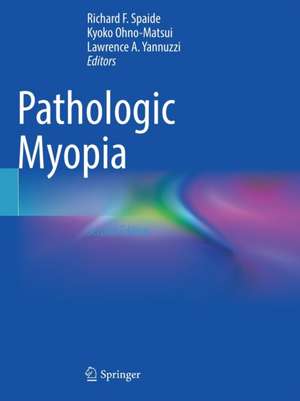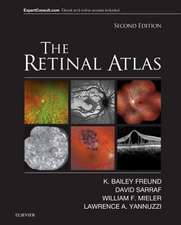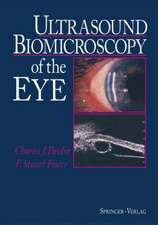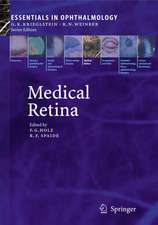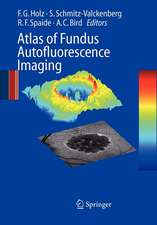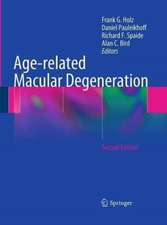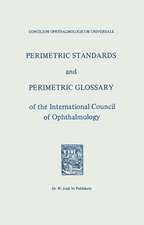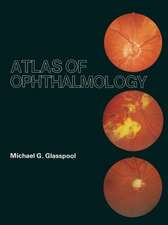Pathologic Myopia
Editat de Richard F. Spaide, Kyoko Ohno-Matsui, Lawrence A. Yannuzzien Limba Engleză Paperback – 29 iul 2022
This new edition is a timely update to the standard reference in the field, with new chapters on advanced refractive error correction, genetics, developing a classification system, and special surgical approaches for pathologic myopia. Complete with even more high-quality color images and informative tables, this book is written and edited by leaders in the field and is geared towards ophthalmologists, including residents andfellows in training, glaucoma and cataract specialists, and vitreoretinal macula experts.
| Toate formatele și edițiile | Preț | Express |
|---|---|---|
| Paperback (2) | 872.36 lei 6-8 săpt. | |
| Springer International Publishing – 29 iul 2022 | 872.36 lei 6-8 săpt. | |
| Springer – 23 aug 2016 | 991.19 lei 38-44 zile | |
| Hardback (2) | 1106.24 lei 38-44 zile | |
| Springer International Publishing – 29 iul 2021 | 1106.24 lei 38-44 zile | |
| Springer – 3 dec 2013 | 1975.66 lei 38-44 zile |
Preț: 872.36 lei
Preț vechi: 918.28 lei
-5% Nou
Puncte Express: 1309
Preț estimativ în valută:
166.95€ • 173.65$ • 137.82£
166.95€ • 173.65$ • 137.82£
Carte tipărită la comandă
Livrare economică 14-28 aprilie
Preluare comenzi: 021 569.72.76
Specificații
ISBN-13: 9783030743369
ISBN-10: 3030743365
Pagini: 461
Ilustrații: XVII, 461 p. 275 illus., 214 illus. in color.
Dimensiuni: 210 x 279 mm
Greutate: 1.17 kg
Ediția:2nd ed. 2021
Editura: Springer International Publishing
Colecția Springer
Locul publicării:Cham, Switzerland
ISBN-10: 3030743365
Pagini: 461
Ilustrații: XVII, 461 p. 275 illus., 214 illus. in color.
Dimensiuni: 210 x 279 mm
Greutate: 1.17 kg
Ediția:2nd ed. 2021
Editura: Springer International Publishing
Colecția Springer
Locul publicării:Cham, Switzerland
Cuprins
Section 1 – Basic Science of Pathologic Myopia. .- Chapter 1. Myopia: A Historical Perspective.- Chapter 2. Definition of pathologic myopia (PM).- Chapter 3. Epidemiology of Myopia, High Myopia and Pathological Myopia.- Chapter 4. Genetics of Pathologic Myopia.- Chapter 5. Public Health Impact of Pathologic Myopia.- Chapter 6. Animal Models of Experimental Myopia: Limitations and Synergies with Studies on Human Myopia.- Chapter 7. The Sclera and its Role in Regulation of the Refractive State.- Section 2 - Ocular Changes in the Development of Pathologic Myopia. .- Chapter 8. Update on the Pathology of Pathological Myopia.- Chapter 9. The Sclera and Induced Abnormalities in Myopia.- Chapter 10. The Choroid Fin.- Chapter 11. Theories of Myopization: Potential Role of a Posterioly Expanding Bruch’s Membrane .- Chapter 12. The Optic Nerve Head in High Myopia / Abnormalities of the Intrapapillary and Parapapillary Region.- Chapter 13. Vitreous Changes in Myopia.- Chapter 14. Ultra-widefield imaging of vitreous in pathologic myopia.- Section 3- Sequella of Pathologic Myopia and Their Potential Treatments. .- Chapter 15. Staphyloma I.- Chapter 16. Staphyloma II.- Chapter 17. Overview of OCT-based classification of macular lesions due to pathologic myopia.- Chapter 18. Myopic Maculopathy.- Chapter 19. Choroidal Neovascularization.- Chapter 20. Myopic Macular Retinoschisis.- Chapter 21. surgical approaches for complications of PM.- Chapter 22. Peripheral Retinal Abnormalities.- Chapter 23. Retinal Detachment.- Chapter 24. Glaucoma in Myopia.- Chapter 25. Myopic Optic Neuropathy.- Chapter 26. Special Considerations for Cataract Surgery in the Face of Pathologic Myopia.- Chapter 27. Ocular Motility Abnormalities.- Chapter 28. Ocular and Systemic Disease.- Section 4 - Treatment of pathologic myopia. .- Chapter 29. Prevention of myopia progression in children and adolescents.- Chapter 30. OPTICAL METHODS TO SLOW THE PROGRESSION OF MYOPIA.- Chapter 31. Sclera-targeted therapies for pathologic myopia.-
Notă biografică
Richard F. Spaide, MD
Vitreous, Retina, Macula Consultants of New York
rick.spaide@gmail.com
Kyoko Ohno-Matsui
Department of Ophthalmology and Visual Science
Tokyo Medical and Dental University
k.ohno.oph@tmd.ac.jp
Lawrence A. Yannuzzi, MD
Professor of Clinical Ophthalmology
College of Physicians and Surgeons
Columbia University
Founder, Director and President of The Macula Foundation, Inc.
New York, NY, USA
layannuzzi@gmail.com
Textul de pe ultima copertă
Pathologic Myopia is a major cause of severe vision loss worldwide. The mechanisms for vision loss include cataract, glaucoma, retinal detachment, and above all, myopic maculopathy within the posterior staphyloma. The first edition of Pathologic Myopia is one of the only current books to specifically address this disease and discusses recent developments in imaging technologies and various approaches to treatments, such as laser photocoagulation, photodynamic therapy, pharmaco-therapeutic injections in the vitreous, and surgery.
This new edition is a timely update to the standard reference in the field, with new chapters on advanced refractive error correction, genetics, developing a classification system, and special surgical approaches for pathologic myopia. Complete with even more high-quality color images and informative tables, this book is written and edited by leaders in the field and is geared towards ophthalmologists, including residents and fellows in training, glaucoma and cataract specialists, and vitreoretinal macula experts.
This new edition is a timely update to the standard reference in the field, with new chapters on advanced refractive error correction, genetics, developing a classification system, and special surgical approaches for pathologic myopia. Complete with even more high-quality color images and informative tables, this book is written and edited by leaders in the field and is geared towards ophthalmologists, including residents and fellows in training, glaucoma and cataract specialists, and vitreoretinal macula experts.
Caracteristici
The updated second edition will specifically address pathologic myopia, and include updates in treatment Edited by two of the leaders in the field Discusses recent developments in imaging technologies and various approaches in treatment Aimed at ophthalmologists, including residents and fellows, glaucoma and cataract specialists, and vitreoretinal macula experts?
Recenzii
From
the
reviews:
“This book presents the definition, epidemiology, and genetics of myopia and an analysis of the human eye shape and pathologies and possible therapies for pathological myopia. … Intended for ophthalmologists, the book is written in such a way that both comprehensive ophthalmologists and retina specialists may find it useful. … This is a wonderful fount of information on myopia and pathological myopia. It is likely the most complete book on the topic currently available.” (Elizabeth C. Chiang, Doody’s Book Reviews, May, 2014)
“This book presents the definition, epidemiology, and genetics of myopia and an analysis of the human eye shape and pathologies and possible therapies for pathological myopia. … Intended for ophthalmologists, the book is written in such a way that both comprehensive ophthalmologists and retina specialists may find it useful. … This is a wonderful fount of information on myopia and pathological myopia. It is likely the most complete book on the topic currently available.” (Elizabeth C. Chiang, Doody’s Book Reviews, May, 2014)
